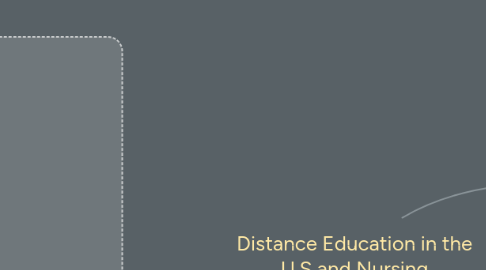
1. Current State of Distance Education
1.1. Positives
1.1.1. Nurses are at the forefront of evidence-based improvments and leading innovation in an atmosphere of accelerating change
1.1.2. Distance education connects teachers and students to learning opportunities that can be accessible to students who live far from the faculty.
1.1.3. Learning opportunities can occur on demand at a time and place convenient for the learner.
1.1.4. Distance Education improves recruitment and retention for schools of nursing and health care agencies.
1.2. Negatives
1.2.1. Need for qualified nurse educators
1.2.2. Need for baccalaurete degreed nurses
1.2.3. Distant Education does not fit everyone's lifestyle and learning style.
1.2.4. Distance education requires additional course preparation and role changes for faculty and students.
1.2.5. Distance Education programs are expensive.
2. Distance Education vs. Online Education vs Correspondence Course
2.1. Distance Education: a process that includes courses taught the mail, by DVD, or via phone or TV. This type of learning typically doesn't require learners to be in the classroom setting; or in a setting where the teacher and learner are in the same place.
2.1.1. Regular and substantive interaction between the students and the instructor. If the materials are provided but interaction between instructor and students is not regular and substantive, then the course is a correspondence course not a distance education course.
2.2. Online Education: education which is delivered and administered using the internet
2.2.1. Can cost less to learner since classes are exclusively online.
2.3. Correspondence Course: a class that is carried out through distance learning, whether that is online or with pre-printed materials that are posted in a learning platform (Canvas), mailed or faxed. Some correspondence courses may be only for career or personal development, while others might offer college credit that can go towards a degree.
2.3.1. Students are not entitled to financial aid. If students are receiving financial aid for a course that the Department of Education auditors consider to be a correspondence course, then the college is responsible for refunding the money to the Department of Education.
2.3.2. Not distance education course
3. Accreditation Bodies for Higher Education Institutions
3.1. CCNE
3.1.1. The Commission on Collegiate Nursing Education (CCNE) is an autonomous accreditation agency of the American Association of Colleges of Nursing (AACN). Nursing programs that are in the process of getting accreditation have to use the professional standards and guidelines developed by the AACN (Billings & Halstead, 2020).
3.2. NLN CNEA
3.2.1. The National League for Nursing Commission for Nursing Education Accreditation (NLN CNEA) serves as an additional accreditation option (Billings & Halstead, 2020). This accreditation body does not allow for funding.
3.2.2. offers a pre-accreditation status which is appealing to nursing programs that are looking to get started or get back on their feet.

